Truck Driver Shortage Lacks a Woman’s Touch
Supply Chain Reactions
A Condensed Update For American Shippers
Issue Date: November 4, 2020
Quote of the Issue:
“Every storm runs out of rain.”
– Maya Angelou
US Trucking Landscape: Truck Driver Shortage in Spotlight during Surge
ShapLight Focus: Women comprise only 6% of the current truck driving labor force
- According to the American Transportation Research Institute, the top trucking industry concerns for 2021 and beyond include – (1) Driver shortages; (2) Driver retention and compensation; and (3) Compliance, safety, and accountability
- An estimated 40,000 new commercial drivers have not been able to obtain their learner’s permits and/or drivers licenses during COVID due to widespread DMV closures and shuttered training facilities; new licenses are down almost 40% in 2020 compared to 2019 YTD
- In October, 17% fewer trucks were available for spot moves, while spot loads rose over 122%; recent data reveals van spot rates were also up 33% YOY
- FTL rates per mile have remained stable after setting a record in early October; rates have dipped nearly 3 cents per mile to $2.41
- DAT reports that load postings per available truck now sit at a 4:1 ratio nationwide; however, the ratio remains over 5:1 in port cities as they work through tremendously high import surges
- Maersk and other ocean carriers have announced that chassis dwell times are now over seven days for Los Angeles/Long Beach (LA/LB); the crippling congestion for Southern California shows no signs of abatement, with total delays from port to rail averaging over two weeks at present
Government Pork: Trump Attempts to Trump Thailand with GSP
ShapLight Focus: Last week, President Trump revealed that nearly 240 HTS numbers on products from Thailand are scheduled to be removed from the Generalized System of Preferences (GSP) eligibility status in retaliation for Thailand’s continued lack of market access for US pork
- A US-based industry group wrote to the heads of the Senate Finance and House Ways and Means committees in an attempt to argue in favor of GSP being dramatically re-written to protect domestic interests; currently, the GSP program is set to expire at the end of this year (effective 12/31/20)
- The number of ongoing Section 301 litigation cases concerning Lists 3 and 4a tariffs has reached more than 3,500 filers and involves millions of entries
- The US Trade Representative (USTR) has initiated Vietnam Section 301 investigations
- President Trump has extended the Caribbean Basin Trade Partnership Act (CBTPA) through September 30, 2030; this trade preference program is unique in that it requires the use of US-manufactured yarns or fabrics in any finished apparel or goods in order to be eligible for benefits
Airfreight: How Will We Distribute a Vaccine Globally?
ShapLight Focus: Over 50% of air cargo capacity is booked on passenger-aircrafts not currently in service
- The industry has already expressed extreme concerns related to future global vaccine distribution; one of which being air capacity is already inadequate for current cargo demand, especially in cold chain
- Look out world – Apple’s newly released 5G enabled iPhone 12 and iPhone 12 mini are set to dominate outbound Chinese air supply in the coming weeks
- In Hong Kong, Shenzhen, and Shanghai, 3-4-day shipping backlogs are the current normal; airfreight rates to the US from these origins are expected to eclipse $9/kg, and could easily go above $10/kg
- Although US air passenger traffic is down 64% from 2019, it was able to increase 6% last month (October 2020)
Please note the following three-month airfreight rate trend chart:
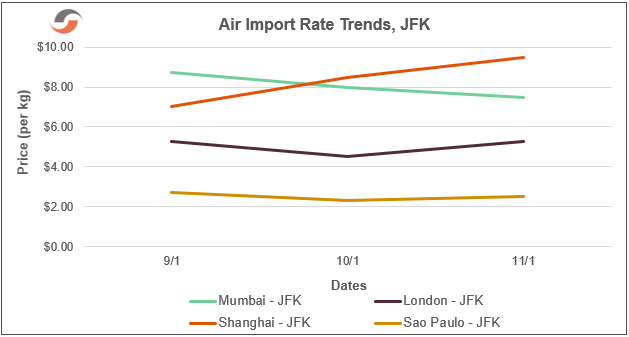
Ocean Freight: Imports from Asia Up Over 90% Since March
ShapLight Focus: This November, the LA/LB, NY/NJ, Savannah, and Miami/Port Everglades terminals are all on pace to surpass their 52-week highs in volumes
- More than 20% of the global fleet sat idle in May, however that ratio has shrunken to a microscopic 1.5%, thereby limiting the ocean carriers’ ability to adjust to future demand spikes
- A recent survey indicated that equipment shortages, port congestion, and chassis shortages are more expensive and disruptive to American importers than the high cost of ocean freight
- In September—October, the average VLSFO price was $335 per ton; Bunker Adjustment Fuel (BAF) levels should be quite close to current levels on January 1st, barring any huge spikes in November
- Since September 4th, the weekly Shanghai Containerized Freight Index (SCFI) has been within $100 for both the West and the East Coast markets
- During the months of August and September, 6 of the 7 largest global steamship lines rolled more than 20% of bookings – which is believed to have established a new record
- Schedule integrity/on-time performance for the steamship industry dipped below 50% on cargo bound from Asia to either of the US coasts (USWC and USEC)
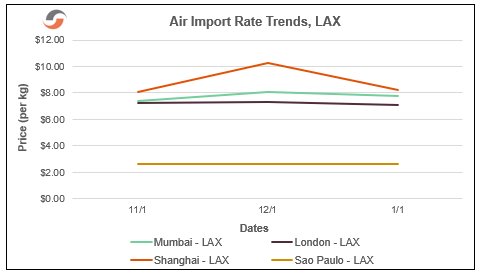
Ocean Freight Import Rate Trend Charts
Ocean Freight – Chart of the Issue:
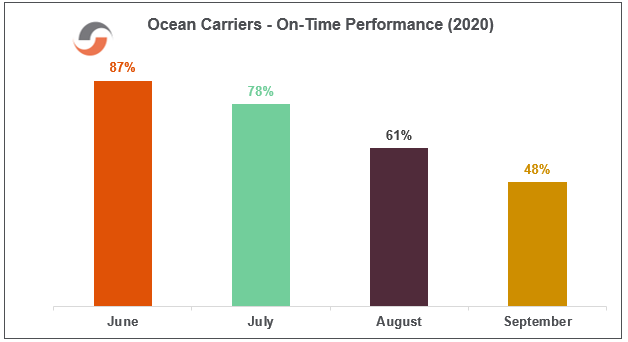
Ocean Import Rates to US West Coast (per 40’):
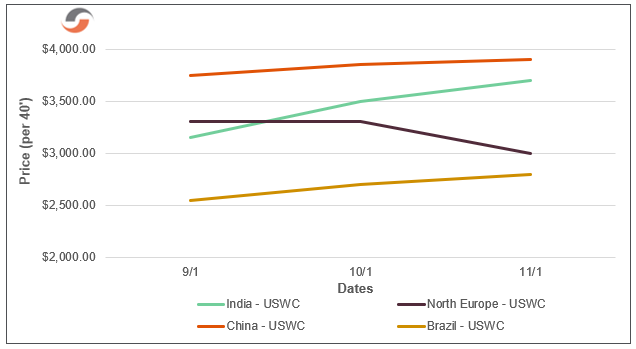
Ocean Import Rates to US East Coast (per 40’):
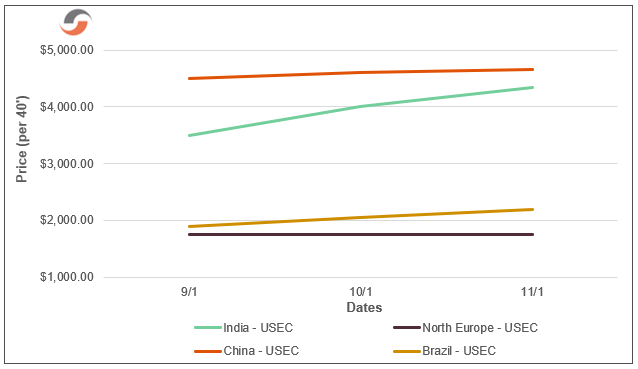
Transpacific Forward Rate Projections (per 40′):
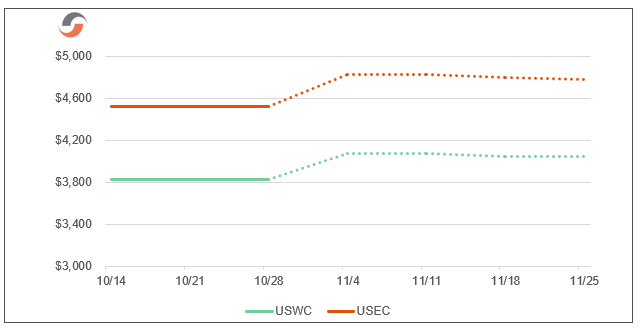
Our Expert Shapinion
Fill-in-the-Blank-Sailings: How the %$#@ do I Budget in %$#@ 2021
Many of us have a calendar year budget, and we are being asked two very difficult questions right now:
- How could you miss your 2020 ocean freight projections by a mile?
- What can we expect for ocean freight spending in 2021?
If you happen to be a diligent follower of Shapiro’s publications and webinars, you might already have plenty to say about #1; however, it’s also likely that you have found #2 to be a real doozy.
Let’s start with a look at bigger picture threats to your supply chain efficiency – these factors may not directly affect ocean freight costs, but they will slow your cargo and potentially create damaging and budget-thumping indirect costs…
Bigger Picture Uncertainties:
- COVID’s global rebound and potential shutdowns
- American political and social unrest
- Cyberattacks
- Logistical realities of a global vaccine distribution
- On-going equipment shortages, port congestion, and chassis shortages
Please note that it is not our intention to demoralize any readers here – instead, it is crucial for all of us to build contingency plans and budget for them in 2021. As it stands today, the unprecedented events seen in 2020 are set to carry into at least half of the upcoming year.
With that in mind, here’s a quick look at the demand side of the ocean freight equation…
Ocean Import Demand Factors:
- Consumer spending in the US has radically shifted from services to goods because of the pandemic
- Domestic spending is up more than 11% on durable goods in 2020 vs. 2019; this marks the largest single-year increase on record
- Strong and continuous demand for shipments containing Personal Protective Equipment (PPE)
- Potential government stimulus plans – what should consumers expect?
- Next year’s inventory levels are being managed and evaluated differently than they were in 2020
Although we are enduring the highest unemployment rate in a generation, pundits have already forecasted 2021 GDP to shrink by 3.5% in the US. On the flip side, the US savings rate has reached well over 10% for the first time in 20 years (this may be a good thing for families, but it lowers consumption). However, another huge question remains – how long can a spike in durable goods spending last? After all, purchases of home appliances, home furnishings, and exercise equipment tend to last a long time and therefore are not likely to represent the foundation for continued spikes in demand.
Now, it is time to shift over to the ocean freight supply side…
Ocean Import Supply Notes:
- As the steamship industry experiences a period of reinvention, it’s become clear that capacity discipline is here to stay amongst the carriers
- Current alliance structures have proven agility through the routine deployment of blank sailings
- Presently, the Global Idle Fleet stands at 1.5% of total potential capacity; this has resulted in the smallest reading of this metric in over a decade
- New vessel orders/manufacturing are modest at best in the foreseeable future
- Moving ahead, the outlook on new vessel building is complicated by the uncertainties of carbon taxes/regulations
Now that we have outlined some of the key pieces of the 2021 transpacific ocean freight puzzle, it is time to offer an indication of future rate levels…
Best Guesses for Transpacific Ocean Imports in 2021 (Current Speculations):
- Contract levels from Asia Base Ports to USEC – $3100 to $3400 per 40’ HC
- Contract levels from Asia Base Ports to USWC – $2200 to $2400 per 40’ HC
- Average spot rate costs – $500 higher than the above contract rate levels
- Chassis and free time negotiations will be tremendously amplified
Today, the spot market sits well over $2000 higher per container than contract rates. At the same time, a very large population of importers holding contracts have agreed to general rate increases (GRIs) and/or have moved some of their cargo to premium services. We see little evidence that the carriers will have an incentive to slash average net rates for contracts come next April and May. However, we believe that supply discipline will be the most significant factor when it comes time to guesstimate 2021 ocean freight levels.
While the demand picture is shaky at best for the upcoming year, our consensus is that we are headed for the largest contract rate “correction” since 1997. Should demand ebb, we believe that there could very well be a few months of solid bargain hunting awaiting us on the 2021 spot market horizon.
Shap Fact of the Issue:
The US household savings rate – the saved share of net disposable income – skyrocketed to 34% in April and remains at 14% today. Historically, the rate has been below 7% in the US, which is well outside the top 10 countries worldwide.
The leadership and staff of Shapiro understand the personal and business anxiety each of you is experiencing. We want nothing but safety today and a return to normalcy tomorrow for you and your families. Please reach out to us if you have any questions—or if we can assist you in any way.
